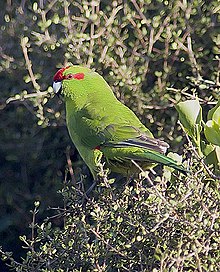| Cyanoramphus | |
|---|---|

| |
| Red-crowned parakeet (Cyanoramphus novaezelandiae) | |
| Scientific classification | |
| Domain: | Eukaryota |
| Kingdom: | Animalia |
| Phylum: | Chordata |
| Class: | Aves |
| Order: | Psittaciformes |
| Family: | Psittaculidae |
| Tribe: | Platycercini |
| Genus: | Cyanoramphus Bonaparte, 1854 |
| Species | |
|
Cyanoramphus auriceps | |
Cyanoramphus is a genus of parakeets native to New Zealand and islands of the southern Pacific Ocean. The New Zealand species are often called kākāriki. They are small to medium-sized parakeets with long tails and predominantly green plumage. Most species are forest dwellers, although several of the subantarctic species live in open grassland. The genus formerly had a widely disjunct distribution: while most of the genus ranged from New Caledonia to Macquarie Island, two species were found in the Society Islands, 4,100 km (2,500 mi) away from the rest. Although the islands between these two areas have yielded many bird fossils, undescribed extinct Cyanoramphus have not yet been found on any of them.[1]
Like many other species of birds, the Cyanoramphus parakeets have suffered from changes brought about by humans. The two species from the Society Islands, the black-fronted parakeet and the Society parakeet, are now extinct, as are the taxa from Lord Howe Island and Macquarie Island, and an undescribed Campbell Island form. One species, the Malherbe's parakeet (C. malherbi), is critically endangered, while most other species are endangered or vulnerable. Habitat loss and introduced species are considered responsible for the declines and extinctions.[2]
The genus Cyanoramphus was introduced in 1854 by the French ornithologist Charles Lucien Bonaparte.[3] The genus name combines the Ancient Greek kuanos meaning "dark-blue" and rhamphos meaning "bill".[4] The type species was designated by English zoologist George Robert Gray in 1855 as what is now the extinct black-fronted parakeet (Cyanoramphus zealandicus).[5][6]
- ^ Steadman, D. (2006). Extinction and Biogeography in Tropical Pacific Birds. University of Chicago Press. ISBN 978-0-226-77142-7.
- ^ Taylor, R. (1979). "How the Macquarie Island Parakeet became extinct" (PDF). New Zealand Journal of Ecology. 2: 42–45.
- ^ Bonaparte, Charles Lucien (1854). "Tableau des perroquets". Revue et Magasin de Zoologie Pure et Appliquée. 2nd series. 6: 145–158 [153].
- ^ Jobling, James A. (2010). The Helm Dictionary of Scientific Bird Names. London: Christopher Helm. p. 128. ISBN 978-1-4081-2501-4.
- ^ Gray, George Robert (1855). Catalogue of the Genera and Subgenera of Birds Contained in the British Museum. London: British Museum. p. 86.
- ^ Peters, James Lee, ed. (1937). Check-list of Birds of the World. Vol. 3. Cambridge, Massachusetts: Harvard University Press. p. 269.